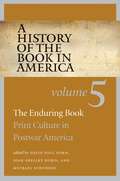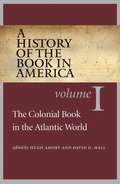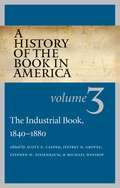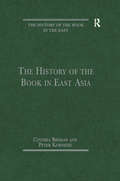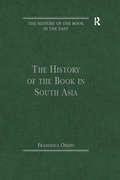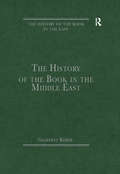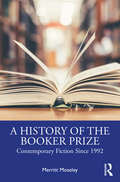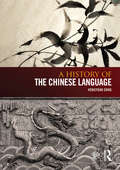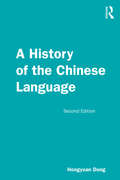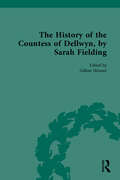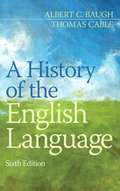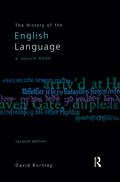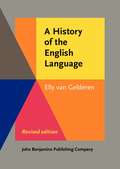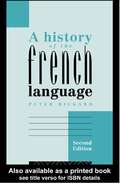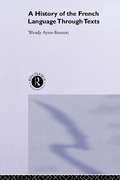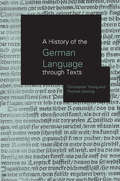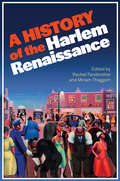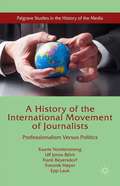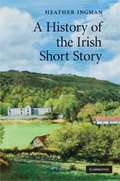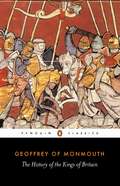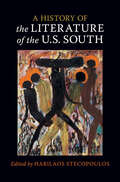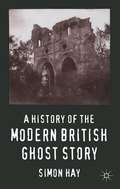- Table View
- List View
A History of the Book in America
by Michael Schudson Joan Shelley Rubin David Paul NordThe fifth volume of A History of the Book in America addresses the economic, social, and cultural shifts affecting print culture from World War II to the present. During this period factors such as the expansion of government, the growth of higher education, the climate of the Cold War, globalization, and the development of multimedia and digital technologies influenced the patterns of consolidation and diversification established earlier.The thirty-three contributors to the volume explore the evolution of the publishing industry and the business of bookselling. The histories of government publishing, law and policy, the periodical press, literary criticism, and reading--in settings such as schools, libraries, book clubs, self-help programs, and collectors' societies--receive imaginative scrutiny as well. The Enduring Book demonstrates that the corporate consolidations of the last half-century have left space for the independent publisher, that multiplicity continues to define American print culture, and that even in the digital age, the book endures.Contributors:David Abrahamson, Northwestern UniversityJames L. Baughman, University of Wisconsin-MadisonKenneth Cmiel (d. 2006)James Danky, University of Wisconsin-MadisonRobert DeMaria Jr., Vassar CollegeDonald A. Downs, University of Wisconsin-MadisonRobert W. Frase (d. 2003)Paul C. Gutjahr, Indiana UniversityDavid D. Hall, Harvard Divinity SchoolJohn B. Hench, American Antiquarian SocietyPatrick Henry, New York City College of TechnologyDan Lacy (d. 2001)Marshall Leaffer, Indiana UniversityBruce Lewenstein, Cornell UniversityElizabeth Long, Rice UniversityBeth Luey, Arizona State UniversityTom McCarthy, Beirut, LebanonLaura J. Miller, Brandeis UniversityPriscilla Coit Murphy, Chapel Hill, N.C.David Paul Nord, Indiana UniversityCarol Polsgrove, Indiana UniversityDavid Reinking, Clemson UniversityJane Rhodes, Macalester CollegeJohn V. Richardson Jr., University of California, Los AngelesJoan Shelley Rubin, University of RochesterMichael Schudson, University of California, San Diego, and Columbia UniversityLinda Scott, University of OxfordDan Simon, Seven Stories PressIlan Stavans, Amherst CollegeHarvey M. Teres, Syracuse UniversityJohn B. Thompson, University of CambridgeTrysh Travis, University of FloridaJonathan Zimmerman, New York University
A History of the Book in America, 5-volume Omnibus E-book
by David D. HallThe five volumes in A History of the Book in America offer a sweeping chronicle of our country's print production and culture from colonial times to the end of the twentieth century. This interdisciplinary, collaborative work of scholarship examines the book trades as they have developed and spread throughout the United States; provides a history of U.S. literary cultures; investigates the practice of reading and, more broadly, the uses of literacy; and links literary culture with larger themes in American history.Now available for the first time, this complete Omnibus ebook contains all 5 volumes of this landmark work.Volume 1The Colonial Book in the Atlantic WorldEdited by Hugh Amory and David D. Hall664 pp., 51 illus.Volume 2An Extensive Republic: Print, Culture, and Society in the New Nation, 1790-1840Edited by Robert A. Gross and Mary Kelley712 pp., 66 illus.Volume 3The Industrial Book, 1840-1880Edited by Scott E. Casper, Jeffrey D. Groves, Stephen W. Nissenbaum, and Michael Winship560 pp., 43 illus.Volume 4Print in Motion: The Expansion of Publishing and Reading in the United States, 1880-1940Edited by Carl F. Kaestle and Janice A. Radway688 pp., 74 illus.Volume 5The Enduring Book: Print Culture in Postwar AmericaEdited by David Paul Nord, Joan Shelley Rubin, and Michael Schudson632 pp., 95 illus.
A History of the Book in America- Volume 3
by David D. Hall Hugh AmoryThe Colonial Book in the Atlantic World carries the interrelated stories of publishing, writing, and reading from the beginning of the colonial period in America up to 1790. Three major themes run through the volume: the persisting connections between the book trade in the Old World and the New, evidenced in modes of intellectual and cultural exchange and the dominance of imported, chiefly English books; the gradual emergence of a competitive book trade in which newspapers were the largest form of production; and the institution of a "culture of the Word," organized around an essentially theological understanding of print, authorship, and reading, complemented by other frameworks of meaning that included the culture of republicanism. The Colonial Book in the Atlantic World also traces the histories of literary and learned culture, censorship and "freedom of the press," and literacy and orality.Contributors:Hugh AmoryRoss W. Beales, The College of the Holy CrossJohn Bidwell, Princeton University LibraryRichard D. Brown, University of ConnecticutCharles E. Clark, University of New HampshireJames N. Green, Library Company of PhiladelphiaDavid D. Hall, Harvard Divinity SchoolRussell L. Martin, Southern Methodist UniversityE. Jennifer Monaghan, Brooklyn College of The City University of New YorkJames Raven, University of EssexElizabeth Carroll Reilly, Hardwick, MassachusettsA. Gregg Roeber, Pennsylvania State UniversityDavid S. Shields, University of South CarolinaCalhoun Winton, University of Maryland
A History of the Book in America- Volume 5
by Michael Winship Stephen W. Nissenbaum Jeffrey D. Groves Scott E. CasperVolume 3 of A History of the Book in America narrates the emergence of a national book trade in the nineteenth century, as changes in manufacturing, distribution, and publishing conditioned, and were conditioned by, the evolving practices of authors and readers. Chapters trace the ascent of the "industrial book--a manufactured product arising from the gradual adoption of new printing, binding, and illustration technologies and encompassing the profusion of nineteenth-century printed materials--which relied on nationwide networks of financing, transportation, and communication. In tandem with increasing educational opportunities and rising literacy rates, the industrial book encouraged new sites of reading; gave voice to diverse communities of interest through periodicals, broadsides, pamphlets, and other printed forms; and played a vital role in the development of American culture.Contributors:Susan Belasco, University of NebraskaCandy Gunther Brown, Indiana UniversityKenneth E. Carpenter, Newton Center, MassachusettsScott E. Casper, University of Nevada, RenoJeannine Marie DeLombard, University of TorontoAnn Fabian, Rutgers UniversityJeffrey D. Groves, Harvey Mudd CollegePaul C. Gutjahr, Indiana UniversityDavid D. Hall, Harvard Divinity SchoolDavid M. Henkin, University of California, BerkeleyBruce Laurie, University of Massachusetts, AmherstEric Lupfer, Humanities TexasMeredith L. McGill, Rutgers UniversityJohn Nerone, University of IllinoisStephen W. Nissenbaum, University of MassachusettsLloyd Pratt, Michigan State UniversityBarbara Sicherman, Trinity CollegeLouise Stevenson, Franklin & Marshall CollegeAmy M. Thomas, Montana State UniversityTamara Plakins Thornton, State University of New York, BuffaloSusan S. Williams, Ohio State UniversityMichael Winship, University of Texas at Austin
The History of the Book in East Asia (The History of the Book in the East)
by Cynthia BrokawThe history of the book in East Asia is closely linked to problems of language and script, problems which have also had a profound impact on the technology of printing and on the social and intellectual impact of print in this area. This volume contains key readings on the history of printed books and manuscripts in China, Korea and Japan and includes an introduction which provides an overview of the history of the book in East Asia and sets the readings in their context.
The History of the Book in South Asia (The History of the Book in the East)
by Francesca OrsiniThe History of the Book in South Asia covers not only the various modern states that make up South Asia today but also a multitude of languages and scripts. For centuries it was manuscripts that dominated book production and circulation, and printing technology only began to make an impact in the late eighteenth century. Print flourished in the colonial period and in particular lithographic printing proved particularly popular in South Asia both because it was economical and because it enabled multi-script printing. There are now vibrant publishing cultures in the nation states of South Asia, and the essays in this volume cover the whole range from palm-leaf manuscripts to contemporary print culture.
The History of the Book in the Middle East (The History of the Book in the East)
by Geoffrey RoperThis selection of papers by scholarly specialists offers an introduction to the history of the book and book culture in West Asia and North Africa from antiquity to the 20th century. The flourishing and long-lived manuscript tradition is discussed in its various aspects - social and economic as well as technical and aesthetic. The very early but abortive introduction of printing - long before Gutenberg - and the eventual, belated acceptance of the printed book and the development of print culture are explored in further groups of papers. Cultural, aesthetic, technological, religious, social, political and economic factors are all considered throughout the volume. Although the articles reflect the predominance in the area of Muslim books - Arabic, Persian and Turkish - the Hebrew, Syriac and Armenian contributions are also discussed. The editor’s introduction provides a survey of the field from the origins of writing to the modern literary and intellectual revivals.
A History of the Booker Prize: Contemporary Fiction Since 1992
by Merritt MoseleyIn this book, Merritt Moseley offers a brief history of the Booker Prize since 1992. With a short chapter covering each year, we follow the change in criteria, the highs and lows, short lists, winners, and controversies of the Booker Prize. The book also functions as an example of literary criticism for each of the books involved, analyzing the judging process and the winning books. Exploring themes such as literary vs. popular fiction, the role of Postcolonial work in what began as a very "British" prize, the role of marketing, publishing, and the Booker organization itself, the book offers a crucial view into literary prize culture. The book spends time looking at exclusions, as well as the overall role and function of the literary prize. What books aren’t included and why? Why has the Booker become so significant? This book will be of use to anyone with an interest in, or studying, contemporary literature, literary prizes, literary culture and British literature, as well as publishing studies.
A History of the Chinese Language
by Hongyuan DongA History of the Chinese Language provides a comprehensive introduction to the historical development of the Chinese language from its proto Sino-Tibetan roots in prehistoric times to Modern Standard Chinese. Taking a highly accessible and balanced approach, it presents a chronological survey of the various stages of Chinese language development, covering crucial aspects such as phonology, syntax and semantics. Features include: Coverage of the key historical stages in Chinese language development, such as Old Chinese, Middle Chinese, Early Modern Chinese, Classical Chinese and Modern Standard Chinese Treatment of core linguistic aspects of the Chinese language including phonological changes, grammatical development, lexical evolution, vernacular writing, Chinese characters and Modern Chinese dialects Inclusion of many authentic Chinese legends and texts throughout the book, presented through a rigorous framework of linguistic analysis to help students to build up strong critical and evaluative skills and acquire valuable cultural knowledge Integration of materials from different disciplines, such as archaeology, anthropology, history and sociolinguistics, to highlight the cultural and social background of each period of the language Helpful appendices to aid students with no prior knowledge of linguistics or the Chinese language Companion website at www.routledge.com/cw/dong offering a wealth of supplementary resources such as additional exercises, answer keys and audio recordings of the sounds of Middle and Old Chinese. Written by a highly experienced instructor, A History of the Chinese Language will be an essential resource for beginning students of Chinese Language and Linguistics and for anyone interested in the history and culture of China.
A History of the Chinese Language
by Hongyuan DongA History of the Chinese Language provides a comprehensive introduction to the historical development of the Chinese language from its Proto-Sino-Tibetan roots in prehistoric times to Modern Standard Chinese. Taking a highly accessible and balanced approach, it presents a chronological survey of the various stages of the Chinese language, covering key aspects such as phonology, syntax, and semantics. The second edition presents a revised and updated version that reflects recent scholarship in Chinese historical linguistics and new developments in related disciplines. Features include: Coverage of the major historical stages in Chinese language development, such as Old Chinese, Middle Chinese, Early Modern Chinese, and Modern Standard Chinese. Treatment of core linguistic aspects of the Chinese language, including phonological changes, grammatical development, lexical evolution, vernacular writing, the Chinese writing system, and Chinese dialects. Inclusion of authentic Chinese texts throughout the book, presented within a rigorous framework of linguistic analysis to help students to build up critical and evaluative skills and acquire valuable cultural knowledge. Integration of materials from different disciplines, such as archaeology, genetics, history, and sociolinguistics, to highlight the cultural and social background of each period of the language. Written by a highly experienced instructor, A History of the Chinese Language will be an essential resource for students of Chinese language and linguistics and for anyone interested in the history and culture of China.
The History of the Countess of Dellwyn, by Sarah Fielding (Chawton House Library: Women's Novels)
by Gillian SkinnerSarah Fielding was one of the most respected women authors of her generation and a key figure in the development of the novel. She was admired especially by Samuel Richardson, who famously commented that her ‘knowledge of the human heart’ was greater than that of her brother, the novelist Henry Fielding. This edition revives The Countess of Dellwyn, the only one of Sarah Fielding’s major works not previously available in a modern scholarly edition. The novel is satirical and didactic, taking as its targets fashionable life and modern marriage (and scandalous divorce) and narrated with acerbic wit by its anonymous third-person narrator. This edition benefits greatly from Gillian Skinner’s editorial work and it is a book that will be of great interest to researchers into the eighteenth-century novel and women’s writing of the period worldwide.
A History Of The English Language
by Albert Baugh Thomas CableComprehensive and balanced, this classic exploration of the history of the English language combines internal linguistic history and external cultural history—from the Middle Ages to the present. Students are encouraged to develop both an understanding of present-day English and an enlightened attitude toward questions affecting the language today.
The History of the English Language: A Sourcebook
by David BurnleyThis second edition of The History of the English Language- A Sourcebook provides a comprehensive and accessible guide to the origins and development of the English language. First published in 1992, the book contains over fifty illustrative passages, drawn from the oldest English to the twentieth century. The passages are contextualised by individual introductions and grouped into the traditional periods of Old English, Early Middle English, Later Middle English, Early Modern English and Modern English. These periods are connected by brief essays explaining the major linguistic developments associated with each period, to produce a continuous outline history.For this new edition Professor Burnley has expanded the outline of linguistic features at each of the main chronological divisions and included more selections and illustrations. A new section has also been included to illustrate the language of advertising from the 18th century to the present. The book will be of general interest to all those interested in the origins and development of the English language, and in particular to students and teachers of the history of the English language at A-level and university.
A History of the English Language (Revised Edition)
by Elly Van GelderenThe English language in its complex shapes and forms changes fast. This thoroughly revised edition has been refreshed with current examples of change and has been updated regarding archeological research. Most suggestions brought up by users and reviewers have been incorporated, for instance, a family tree for Germanic has been added, Celtic influence is highlighted much more, there is more on the origin of Chancery English, and internal and external change are discussed in much greater detail. The philosophy of the revised book remains the same with an emphasis on the linguistic history and on using authentic texts. My audience remains undergraduates (and beginning graduates). The goals of the class and the book are to come to recognize English from various time periods, to be able to read each stage with a glossary, to get an understanding of typical language change, internal and external, and to understand something about language typology through the emphasis on the change from synthetic to analytic. This book has a companion website: http://dx. doi. org/10. 1075/z. 183. website
A History of the French Language
by Peter RickardThis well-established and popular book provides students with all the linguistic background they need for studying any period of French literature. For the second edition the text has been revised and updated throughout, and the two final chapters on contemporary French, and its position as a world language, have been completely rewritten. Starting with a brief description of the Vulgar Latin spoken in Gaul, and the earliest recorded forms of French, Peter Rickard traces the development of the language through the later Middle Ages and Renaissance to show how it became standardized in a near modern form in the seventeenth and eighteenth centuries.
A History of the French Language Through Texts
by Wendy Ayres-BennettThis new history of the French language allows the reader to see how the language has evolved for themselves. It combines texts and extracts with a readable and detailed commentary allowing the language to be viewed both synchronically and diachronically.Core texts range from the ninth century to the present day highlight central features of the language, whilst a range of shorter texts illustrate particular points.The inclusion of non-literary, as well as literary texts serves to illustrate some of the many varieties of French whether in legal, scientific, epistolatory, administrative or liturgical or in more popular domains, including attempts to represent spoken usage.This is essential reading for the undergraduate student of French.
A History of the German Language Through Texts
by Christopher Young Thomas GloningA History of the German Language Through Texts examines the evolution of German, from the Early Medieval period to the present day.Written in a lively and accessible style, the book looks at the history of German through a wide range of texts, from medical, legal and scientific writing to literature, everyday newspapers and adverts. All texts are translated and accompanied by commentaries. The book also offers a glossary of technical terms and abbreviations, a summary of the main changes in each historical period, a guide to reference material, and suggestions for further reading.A History of the German Language Through Texts is essential reading for students of German, Linguistics or Philology.
A History of the Harlem Renaissance
by Rachel Farebrother Miriam ThaggertThe Harlem Renaissance was the most influential single movement in African American literary history. The movement laid the groundwork for subsequent African American literature, and had an enormous impact on later black literature world-wide. In its attention to a wide range of genres and forms – from the roman à clef and the bildungsroman, to dance and book illustrations – this book seeks to encapsulate and analyze the eclecticism of Harlem Renaissance cultural expression. It aims to re-frame conventional ideas of the New Negro movement by presenting new readings of well-studied authors, such as Zora Neale Hurston and Langston Hughes, alongside analysis of topics, authors, and artists that deserve fuller treatment. An authoritative collection on the major writers and issues of the period, A History of the Harlem Renaissance takes stock of nearly a hundred years of scholarship and considers what the future augurs for the study of 'the New Negro'.
A History of the Indian Novel in English
by Ulka AnjariaA History of the Indian Novel in English traces the development of the Indian novel from its beginnings in the late nineteenth century up until the present day. Beginning with an extensive introduction that charts important theoretical contributions to the field, this History includes extensive essays that shed light on the legacy of English in Indian writing. Organized thematically, these essays examine how English was 'made Indian' by writers who used the language to address specifically Indian concerns. Such concerns revolved around the question of what it means to be modern as well as how the novel could be used for anti-colonial activism. By the 1980s, the Indian novel in English was a global phenomenon, and India is now the third largest publisher of English-language books. Written by a host of leading scholars, this History invites readers to question conventional accounts of India's literary history.
A History of the International Movement of Journalists: Professionalism Versus Politics (Palgrave Studies in the History of the Media)
by Kaarle Nordenstreng Frank Beyersdorf Svennik H�yer Epp Lauk Ulf BjrkThis study presents a general history of how journalism as an emerging profession became internationally organized over the past one hundred and twenty years, seen mainly through the associations founded to promote the interests of journalists around the world.
A History of the Irish Short Story
by Heather IngmanThough the short story is often regarded as central to the Irish canon, this is the first comprehensive study of the genre for many years. Heather Ingman traces the development of the modern short story in Ireland from its beginnings in the nineteenth century to the present day. Her study analyses the material circumstances surrounding publication, examining the role of magazines and editors in shaping the form. Ingman incorporates the most recent critical thinking on the short story, traces international connections, and gives a central part to Irish women's short stories. Each chapter concludes with a detailed analysis of key stories from the period discussed, featuring Joyce, Edna O'Brien and John McGahern, among others. With its comprehensive bibliography and biographies of authors, this volume will be a key work of reference for scholars and students both of Irish fiction and of the modern short story as a genre.
The History of the Kings of Britain
by Geoffrey of MonmouthCompleted in 1136, The History of the Kings of Britain traces the story of the realm from its supposed foundation by Brutus to the coming of the Saxons some two thousand years later. Vividly portraying legendary and semi-legendary figures such as Lear, Cymbeline, Merlin the magician and the most famous of all British heroes, King Arthur, it is as much myth as it is history and its veracity was questioned by other medieval writers. But Geoffrey of Monmouth's powerful evocation of illustrious men and deeds captured the imagination of subsequent generations, and his influence can be traced through the works of Malory, Shakespeare, Dryden and Tennyson.
A History of the Literature of the U.S. South: Volume 1
by Harilaos StecopoulosA History of the Literature of the U.S. South provides scholars with a dynamic and heterogeneous examination of southern writing from John Smith to Natasha Trethewey. Eschewing a master narrative limited to predictable authors and titles, the anthology adopts a variegated approach that emphasizes the cultural and political tensions crucial to the making of this regional literature. Certain chapters focus on major white writers (e.g., Thomas Jefferson, William Faulkner, the Agrarians, Cormac McCarthy), but a substantial portion of the work foregrounds the achievements of African American writers like Frederick Douglass, Zora Neale Hurston, and Sarah Wright to address the multiracial and transnational dimensions of this literary formation. Theoretically informed and historically aware, the volume's contributors collectively demonstrate how southern literature constitutes an aesthetic, cultural and political field that richly repays examination from a variety of critical perspectives.
A History of the Modern British Ghost Story
by Simon HayGhost stories are always in conversation with novelistic modes with which they are contemporary. This book examines examples fromSir Walter Scott, Charles Dickens, Henry James andRudyard Kipling, amongst others, to the end of the twentieth century, looking at how they address empire, class, property, history and trauma. "
A History of the Modernist Novel
by Gregory CastleA History of the Modernist Novel reassesses the modernist canon and produces a wealth of new comparative analyses that radically revise the novel's history. Drawing on American, English, Irish, Russian, French and German traditions, leading scholars challenge existing attitudes about realism and modernism and draw new attention to everyday life and everyday objects. In addition to its exploration of new forms such as the modernist genre novel and experimental historical novel, this book considers the novel in postcolonial, transnational and cosmopolitan contexts. A History of the Modernist Novel also considers the novel's global reach while suggesting that the epoch of modernism is not yet finished.
